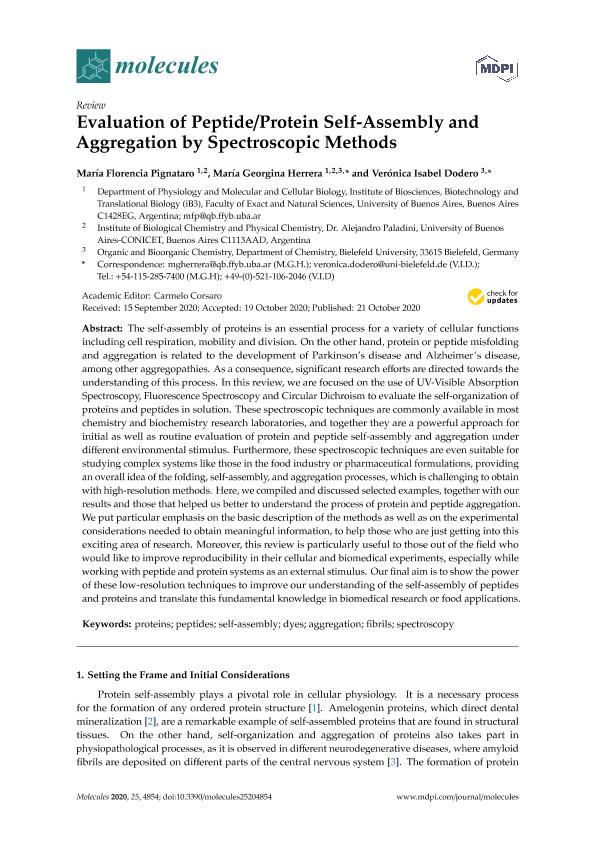Mostrar el registro sencillo del ítem
dc.contributor.author
Pignataro, María Florencia

dc.contributor.author
Herrera, Maria Georgina

dc.contributor.author
Dodero, Verónica Isabel
dc.date.available
2021-05-26T18:05:47Z
dc.date.issued
2020-10
dc.identifier.citation
Pignataro, María Florencia; Herrera, Maria Georgina; Dodero, Verónica Isabel; Evaluation of Peptide/Protein Self-Assembly and Aggregation by Spectroscopic Methods; Molecular Diversity Preservation International; Molecules; 25; 20; 10-2020; 1-35
dc.identifier.issn
1420-3049
dc.identifier.uri
http://hdl.handle.net/11336/132576
dc.description.abstract
The self-assembly of proteins is an essential process for a variety of cellular functions including cell respiration, mobility and division. On the other hand, protein or peptide misfolding and aggregation is related to the development of Parkinson’s disease and Alzheimer’s disease, among other aggregopathies. As a consequence, significant research efforts are directed towards the understanding of this process. In this review, we are focused on the use of UV-Visible Absorption Spectroscopy, Fluorescence Spectroscopy and Circular Dichroism to evaluate the self-organization of proteins and peptides in solution. These spectroscopic techniques are commonly available in most chemistry and biochemistry research laboratories, and together they are a powerful approach for initial as well as routine evaluation of protein and peptide self-assembly and aggregation under different environmental stimulus. Furthermore, these spectroscopic techniques are even suitable for studying complex systems like those in the food industry or pharmaceutical formulations, providing an overall idea of the folding, self-assembly, and aggregation processes, which is challenging to obtain with high-resolution methods. Here, we compiled and discussed selected examples, together with our results and those that helped us better to understand the process of protein and peptide aggregation. We put particular emphasis on the basic description of the methods as well as on the experimental considerations needed to obtain meaningful information, to help those who are just getting into this exciting area of research. Moreover, this review is particularly useful to those out of the field who would like to improve reproducibility in their cellular and biomedical experiments, especially while working with peptide and protein systems as an external stimulus. Our final aim is to show the power of these low-resolution techniques to improve our understanding of the self-assembly of peptides and proteins and translate this fundamental knowledge in biomedical research or food applications.
dc.format
application/pdf
dc.language.iso
eng
dc.publisher
Molecular Diversity Preservation International

dc.rights
info:eu-repo/semantics/openAccess
dc.rights.uri
https://creativecommons.org/licenses/by-nc-sa/2.5/ar/
dc.subject
AGGREGATION
dc.subject
DYES
dc.subject
FIBRILS
dc.subject
PEPTIDES
dc.subject
PROTEINS
dc.subject
SELF-ASSEMBLY
dc.subject
SPECTROSCOPY
dc.subject.classification
Biofísica

dc.subject.classification
Ciencias Biológicas

dc.subject.classification
CIENCIAS NATURALES Y EXACTAS

dc.title
Evaluation of Peptide/Protein Self-Assembly and Aggregation by Spectroscopic Methods
dc.type
info:eu-repo/semantics/article
dc.type
info:ar-repo/semantics/artículo
dc.type
info:eu-repo/semantics/publishedVersion
dc.date.updated
2021-04-28T21:28:25Z
dc.journal.volume
25
dc.journal.number
20
dc.journal.pagination
1-35
dc.journal.pais
Suiza

dc.journal.ciudad
Basel
dc.description.fil
Fil: Pignataro, María Florencia. Consejo Nacional de Investigaciones Científicas y Técnicas. Oficina de Coordinación Administrativa Houssay. Instituto de Química y Físico-Química Biológicas "Prof. Alejandro C. Paladini". Universidad de Buenos Aires. Facultad de Farmacia y Bioquímica. Instituto de Química y Físico-Química Biológicas; Argentina
dc.description.fil
Fil: Herrera, Maria Georgina. Universitat Bielefeld; Alemania. Consejo Nacional de Investigaciones Científicas y Técnicas. Oficina de Coordinación Administrativa Houssay. Instituto de Química y Físico-Química Biológicas "Prof. Alejandro C. Paladini". Universidad de Buenos Aires. Facultad de Farmacia y Bioquímica. Instituto de Química y Físico-Química Biológicas; Argentina
dc.description.fil
Fil: Dodero, Verónica Isabel. Universitat Bielefeld; Alemania
dc.journal.title
Molecules

dc.relation.alternativeid
info:eu-repo/semantics/altIdentifier/url/https://www.mdpi.com/1420-3049/25/20/4854
dc.relation.alternativeid
info:eu-repo/semantics/altIdentifier/doi/http://dx.doi.org/10.3390/molecules25204854
Archivos asociados
